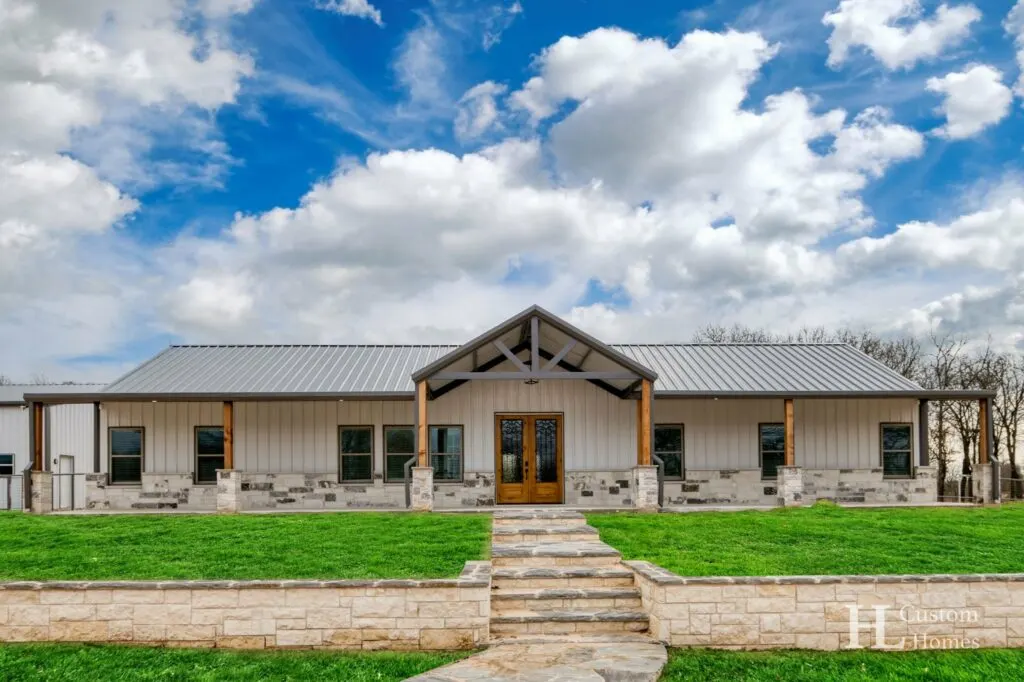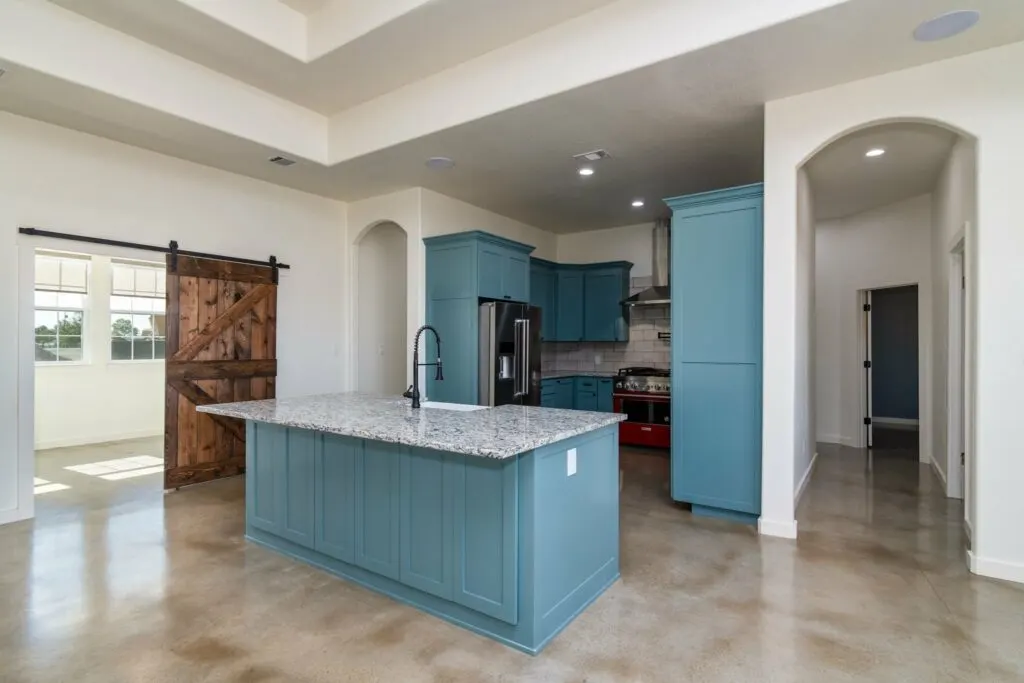When it comes to building a barndominium, there are lots of factors to consider, including the thickness of the walls. This is important because your property’s outer walls will determine the strength and longevity of the structure, as well as the comfort level of its interior. But how thick do barndominium walls need to be?
The answer to that question depends on several variants, such as the climate, the purpose of the building, local safety regulations, and your personal preference. However, there are some industry averages that you can refer to when planning your barndo build. Ready to learn more? Below we explore just how thick barndominium walls typically are and why.
Page Contents
How thick are exterior barndominium walls?

Although the thickness of exterior barndominium walls varies greatly, they are generally between 5-20 inches deep. The actual figure will depend on the layers in your outer walls, each of which impacts the overall thickness. Let’s take a look at each one in more depth.
Outer steel frame
Unlike traditional stone or timber homes, modern barndominiums feature metal outer walls and roofs. These are usually made from solid steel for long-lasting durability, despite being significantly thinner than classic build materials. In fact, the standard 29 gauge steel panels used in most barndo builds are only about 0.17 inches thick. Yet, they can support over 120 pounds per square foot (ideal for snowy conditions) and withstand hurricane-strength winds.
Inner timber frame
This element is an essential part of any barndo build, and it will have the biggest impact on the thickness of your exterior barndominium walls. Typically made from 2×4 timber studs (or 2×6 in cases such as barn conversions), the inner frame attaches to the outer steel frame’s girts which protrude a couple of inches inwards from the outer wall. This timber frame then acts as a bridging inner wall that is most commonly 4-6 inches thick, providing space to house your barndominium insulation. Wiring and plumbing systems can also be fitted within the wall cavity to keep them neatly out of sight, yet relatively easy to access as needed.
Drywall
Once the inner frame and utility fittings are in position, the drywall must be added to close the cavity. Also known as sheetrock or plasterboard, drywall is usually half an inch thick and attaches directly to the timber frame to finish out your barndominium walls ready for décor.
The finished result…
On average, when these three layers are combined, they create sturdy barndominium walls around 8-12 inches thick – a similar depth to their traditional brick-and-mortar counterparts.
How thick are interior barndominium walls?

Interior barndominium walls are those that separate individual rooms within your property. They also consist of 2×4 studs, though the frame is generally slightly thinner than that of exterior walls. This is because they don’t need to house the same level of insulation as an outer wall or the hub of your home’s electrical infrastructure – more likely just a few wires to feed sockets and light switches. As such, interior barndominium walls are usually 3.5 inches thick, with a layer of drywall on each side, taking their total depth to 4.5 inches thick.
Should I choose thinner or thicker walls?
As we mentioned earlier, the wall depths we’ve covered are simply average thicknesses that you’ll likely find in standard barndominium kits. But if you’re creating a custom barndominium from scratch, you can alter the thickness of your barndominium walls to suit your preference.
You’ll just need to ensure they meet the safety regulations for residential buildings in your area to make sure your property is structurally sound. You can usually find this information on your state government website, for example, Virginia.gov or via the ICC’s international building codes. However, any reputable barndominium builder should be able to help you.
Once you’ve confirmed the options available to you, you can then decide whether you’d like to install thick or thinner walls, the benefits of each we’ve covered below…
Benefits of thicker barndominium walls
The main advantage of choosing thicker outer barndominium walls is their insulative properties. Whether you live in a cold state like North Dakota or Minnesota or a hot state like Florida or Texas, regulating the temperature of your property’s interior is key. That way, you can enjoy a comfortable home in all seasons, whatever the weather outside.
Thicker walls create a bigger buffer to keep both cold and warm air out with the help of spray foam, fiberglass blanket, or rigid board insulation. A larger wall cavity can also reduce noise pollution, particularly if you live near a busy road or heavy rainfall is common in your area.
Likewise, although steel barndominium walls offer great protection against the elements, they can still be damaged by flying debris in extreme weather. As such, having walls closer to 20 inches thick reduces the risk of objects penetrating through into your living space.
Benefits of thinner barndominium walls

On the other hand, if you live in one of the many states with a low risk of natural disaster and a moderate climate, such as Michigan or Vermont, then thinner 8 inch walls with a 2-3 inch layer of spray foam insulation should provide a perfectly adequate buffer.
This will then enable you to maximize your interior floor space and create larger rooms that aren’t impacted by the significant depth of the outer walls. Thinner wall frames are also cheaper to construct as they require fewer materials and less insulation to fill the cavities.
Conclusion
In summary, the majority of barndominium walls are around 8-12 inches thick, including the outer steel walls, interior framing, and the drywall that makes up the interior walls. However, some homeowners may choose to increase this to 18-20 inches if they want additional insulation or extra protection against hurricanes and other extreme weather conditions.
Still unsure which way to go? How about installing thicker barndominium walls to encompass your living spaces and adding thinner framing to the walls in your adjacent storage or workshop areas? This will help you save money on your build where superior insulation isn’t quite as important while making sure your home is as comfortable as possible all year round.
If you would like more guides like this one, check out the rest of BarndominiumLife.com. There, you will find more helpful tips and tricks from the pros. You will also find featured barndominiums, barndominium floor plans, and information on financing and insurance. Knowing as much as you can will help you get the best results for your dream home.
Rachel Dawson is an accomplished writer with a passion for all things barndominiums. With over a decade of experience in the industry, Rachel has established herself as one of the leading authorities on the subject of barndominium design and lifestyle.
Her work has been featured in numerous publications, including Barndominium Life, where she regularly contributes articles on a wide range of topics, from design trends and tips to the unique challenges and rewards of living in a barndominium. Rachel’s ability to write with both authority and accessibility has earned her a loyal following among readers and enthusiasts alike.
Her commitment to excellence and her unwavering dedication to the barndominium lifestyle make her a true asset to the Barndominium Life community.
